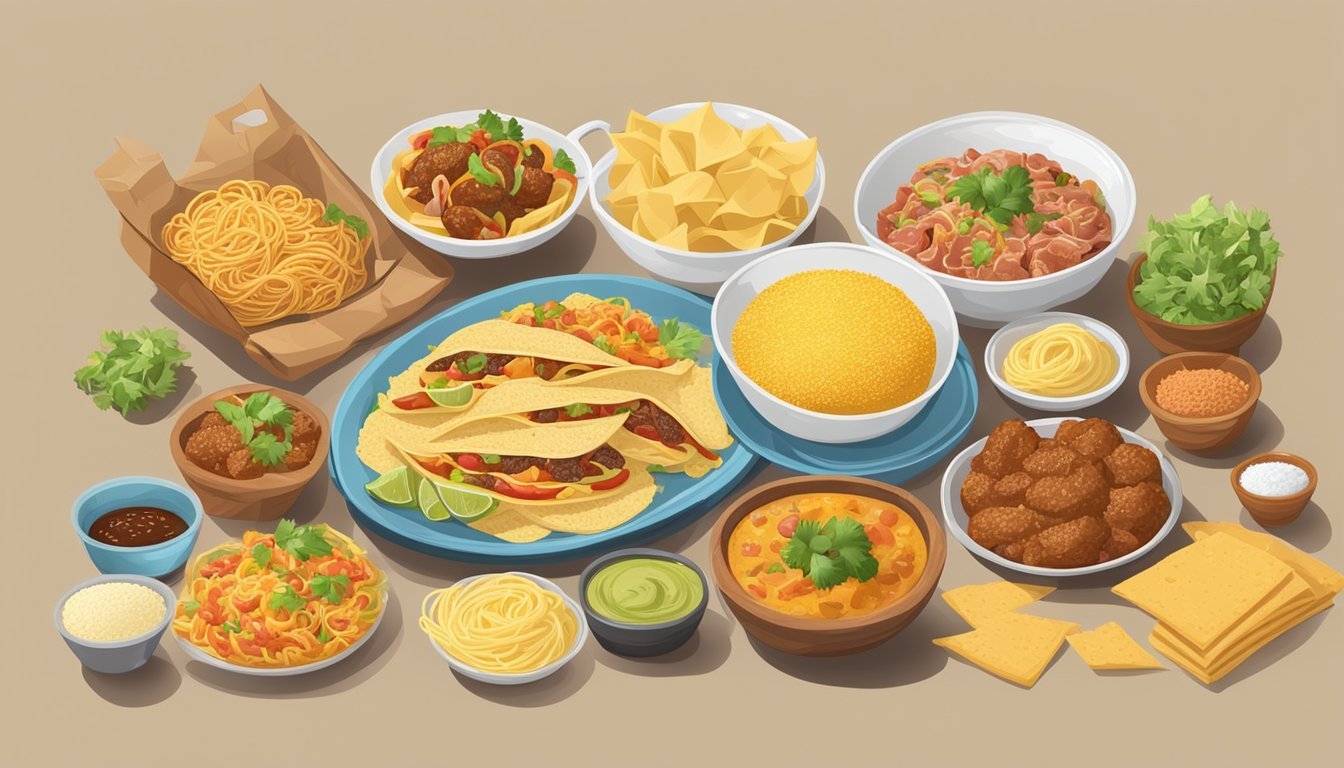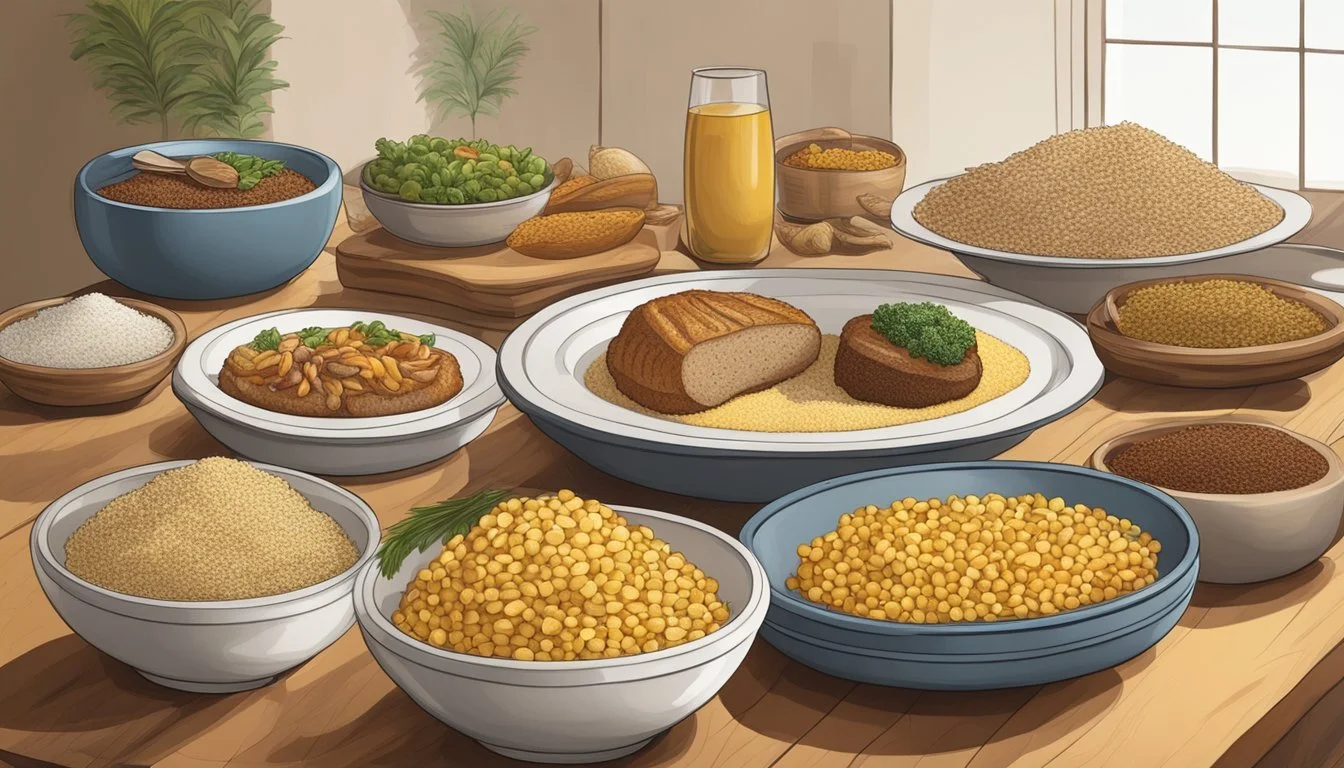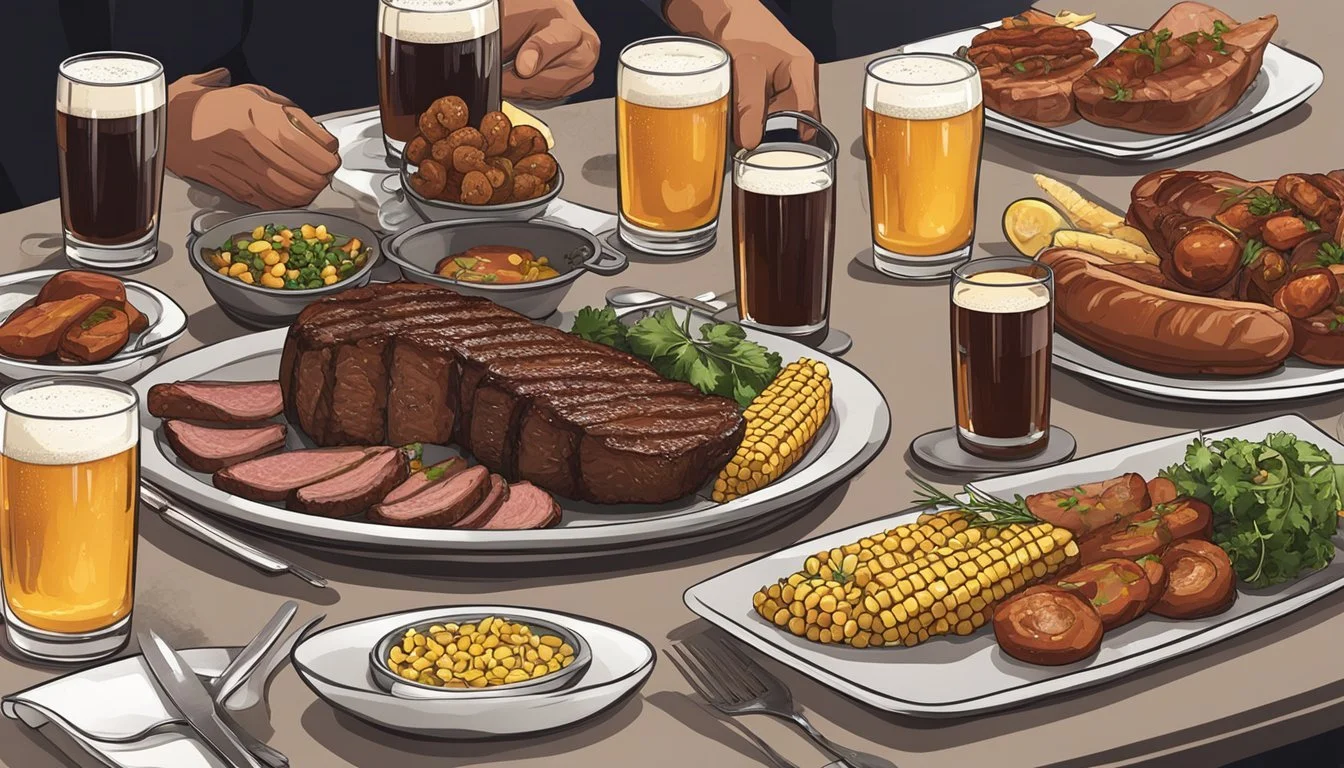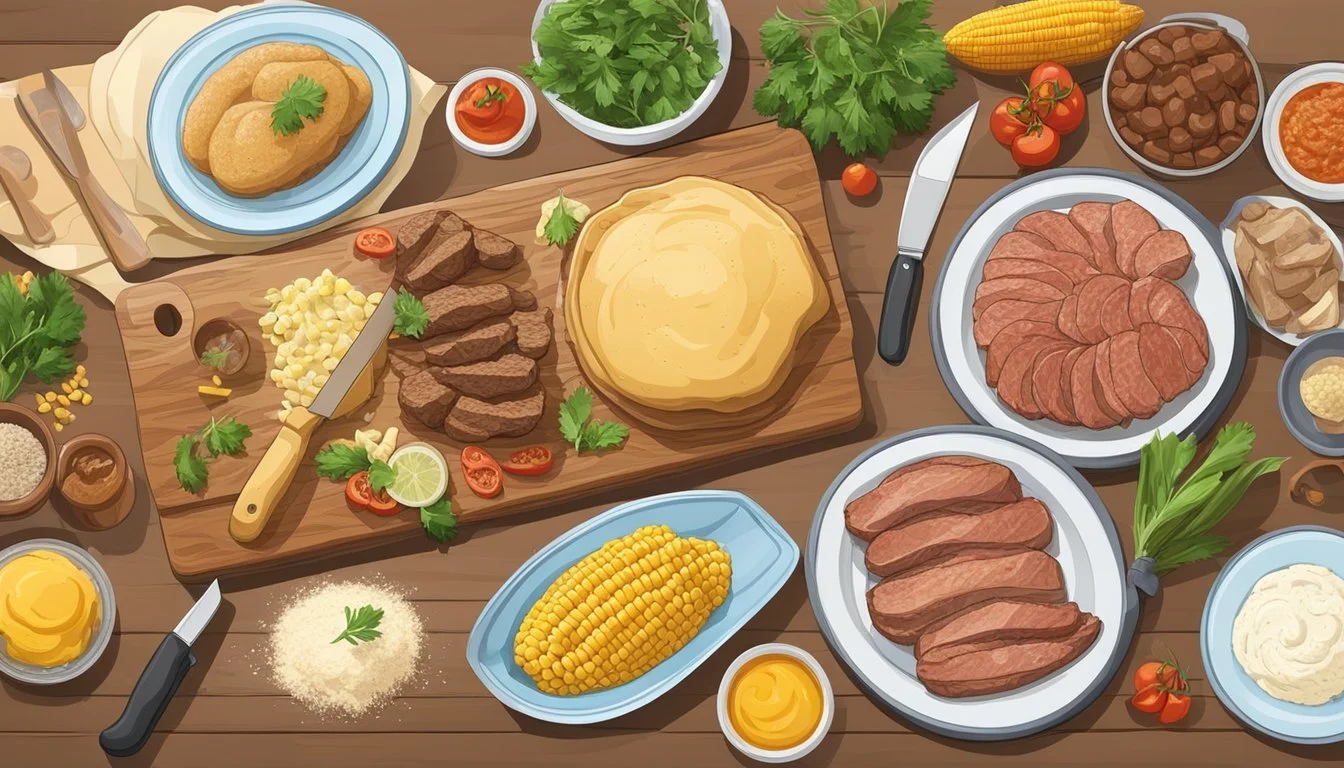Meat Lover's Guide
Choosing Between Flour or Corn-Based Dishes Explained
For meat lovers seeking to elevate their culinary experiences, understanding the difference between flour and corn-based dishes is essential. Both options bring unique textures and flavors to the table. Tender chicken pieces in a rich, creamy tomato-based sauce like Chicken Tikka Masala often benefit from a smooth, fine flour for thickening and enhancing the overall taste.
Corn-based dishes, on the other hand, offer a distinct texture and flavor profile. Recipes such as cornbread or pupusas utilize cornmeal or masa flour, adding a satisfying grit or hearty base that complements savory fillings or toppings. Fine cornmeal creates sweet and savory cornbread, while masa flour is perfect for thick griddled flatbreads filled with meat or cheese.
Choosing between flour and corn-based dishes can significantly impact your meal's outcome. Flour-based recipes tend to be versatile and can seamlessly blend with various sauces and gravies. Meanwhile, cornmeal and masa bring a rustic charm and robustness, ideal for hearty, comforting dishes.
Understanding The Basics
When choosing between flour and corn-based dishes, it's crucial to know the differences in texture, flavor, and nutritional benefits. This section dives deep into the essentials of both flour and corn-based options, ensuring you have a solid grasp of their unique characteristics to make informed decisions in the kitchen.
Flour Fundamentals
Wheat flour, made from grinding wheat kernels, is a versatile ingredient found in numerous recipes. It comes in varied types like all-purpose, bread flour, and cake flour, each having different gluten content. Gluten, a protein, gives elasticity to dough, which is vital for bread and pastries. For those with celiac disease or gluten sensitivity, gluten-free alternatives like almond flour or rice flour are available.
Nutritionally, wheat flour provides carbohydrates, proteins, and several vitamins and minerals like B vitamins and iron. However, it typically lacks fiber, especially in refined forms. Whole wheat flour is a better option for those seeking improved digestion and more nutrients. Flour is essential for baking, thickening sauces, and creating a structure in various baked goods and some savory dishes.
If you're looking for whole wheat flour, buying it online is your best bet!
Corn Essentials
Corn-based ingredients include cornmeal, corn flour, and masa harina. Cornmeal consists of ground maize and varies from fine to coarse textures, perfect for making cornbread and polenta. Corn flour is finely ground and offers a smooth, powdery texture ideal for batters and thickening sauces. Masa harina is nixtamalized corn flour, produced by soaking corn in an alkaline solution, lending a distinct flavor perfect for tortillas and tamales.
Corn products are naturally gluten-free, making them suitable for those with celiac disease or gluten intolerance. They are rich in fiber which aids digestion and provide essential nutrients like vitamin B6, magnesium, and iron. The coarser texture of cornmeal adds a rustic element to dishes, while corn flour's delicate texture is excellent for creating silky sauces and light batters.
Culinary Cultural Context
Flour and corn-based dishes are profoundly shaped by their historical roots and regional variations, reflecting the diverse culinary traditions from various parts of the world.
Historical Significance
Corn has been a staple in the Americas for thousands of years. Indigenous cultures in Mexico and South America first cultivated maize, using it to create corn-based dishes such as tortillas and tamales. These foods had significant cultural roles, providing both sustenance and ceremonial importance.
In contrast, flour-based dishes often stem from European culinary traditions. Wheat cultivation spread across Europe and later to North America. Bread, pasta, and other flour-based staples became integral to daily diets and cultural practices in regions like Italy and France.
Regional Varieties
Corn-based dishes are prominent in many regions. In Mexico and Central America, corn tortillas, tamales, and arepas are widely consumed. South American countries like Venezuela and Colombia also have unique corn-based recipes.
Flour-based dishes vary significantly across regions as well. In North America, Europe, and parts of East Asia, different types of bread, noodles, and pastries are common. Italian cuisine features numerous flour-based items like pasta and pizza, each with distinct regional variations.
In Africa, both corn and flour-based dishes can be found, with cornmeal porridges like Ugali in Kenya. The Caribbean also showcases hybrids, where both corn and flour products are used in diverse ways, reflecting the melting pot of cultural influences.
Protein Picks: Meat Selection
Selecting the right meat boosts nutritional intake, offering high protein and essential nutrients like iron. Two primary categories are beef and pork, which provide rich, flavorful options, and poultry and seafood, known for their lean proteins and versatility.
Beef and Pork
Beef and pork are go-to options for many meat lovers due to their rich flavors and high protein content. Beef, particularly lean cuts such as tenderloin and sirloin, offers a significant amount of protein per serving. It also provides important vitamins and minerals like iron, which is vital for energy production and oxygen transport in the body.
Pork, including tenderloin and chorizo, is another excellent choice. Pork tenderloin is leaner and packs a good protein punch without excessive fat. Chorizo, while higher in fat, adds a unique, spicy flavor to dishes, making it a popular ingredient in various cuisines. Both meats can be incorporated into a variety of recipes, from hearty stews to grilled dishes.
Poultry and Seafood
Poultry and seafood are excellent for those looking to maintain a leaner diet while still getting high-quality proteins. Chicken breast is a staple, known for its versatility and high protein-to-fat ratio. It can be grilled, baked, or sautéed, fitting into numerous recipes. Chicken thighs, though slightly higher in fat, provide a juicy and flavorful alternative.
Seafood such as shrimp and trout also offer substantial protein benefits. Shrimp is low in calories yet high in protein and heart-healthy omega-3 fatty acids. Trout, another nutrient-dense option, is rich in both protein and omega-3s, supporting cardiovascular health. Both can be easily prepared in a variety of ways, including grilling, baking, or sautéing, making them convenient and nutritious choices.
Grains and Accompaniments
A meat lover's meal is not complete without the perfect grains and accompaniments. These complementary sides enhance the main dish with varied textures and flavors, from starchy goodness to creamy richness.
Rice and Potatoes
Rice and potatoes are staples in many diets, offering versatility and comfort. For a hearty meal, white rice serves as an excellent base, soaking up savory juices from meats. Its mild flavor and fluffy texture don't overshadow the main dish.
When it comes to potatoes, options are plentiful. Mashed potatoes with butter and cream provide a smooth, rich counterpart to grilled or roasted meat. Roasted potatoes with herbs can add a crispy texture and earthy flavor. Whether you choose white rice or potatoes, both options can be seasoned to perfection, enhancing the meat's taste.
Beans and Legumes
Beans and legumes are not only nutritious but also pair wonderfully with meaty dishes. Red beans can be slow-cooked with spices, creating a robust side that complements grilled meats. Their hearty texture and ability to absorb flavors make them a fantastic accompaniment.
For something different, incorporating lentils or chickpeas provides a protein-packed option that can be seasoned with various herbs and spices. They add a pleasant, nutty flavor and firm texture to the meal, balancing the meat's richness. Beans and legumes are versatile, allowing for creative pairings that can elevate the dining experience.
Vegetables and Toppings
Vegetables and toppings play a crucial role in balancing a meat-heavy meal. Fresh, crisp veggies like bell peppers, zucchini, and corn bring color and nutrients to the plate. Roasting or grilling these vegetables enhances their natural sweetness and pairs well with hearty meats.
Toppings such as avocado, sour cream, and cheese can add a creamy, tangy, or savory finish. For instance, a dollop of sour cream can cool down spicy meats, while shredded cheese can melt beautifully over hot dishes, adding richness. Avocado provides a creamy texture and subtle flavor that complements various meats, making it a versatile topping.
Correct accompaniments can transform a simple meat dish into a memorable meal.
Classic Dishes and Their Variations
Flour and corn-based dishes each have their own unique history and flavor profile. The selection and preparation methods of these ingredients can significantly impact the final taste and texture of various classic meat dishes.
Tacos and Tortillas
Tacos typically use either flour or corn tortillas as their base. Corn tortillas are more traditional, bringing an earthy flavor and slightly firmer texture. They're usually smaller in size, perfect for street tacos.
Flour tortillas, on the other hand, are softer and more pliable. They provide a milder taste, making them ideal for burrito-style tacos or larger fillings. While corn tortillas are gluten-free, flour tortillas contain gluten, catering to different dietary needs.
Tamales and Enchiladas
Tamales are primarily made with masa harina, a corn-based dough. The choice of filling, which often includes seasoned meat, affects the flavor significantly. Wrapped in corn husks and steamed, tamales have a tender yet firm texture. They can be sweet or savory, depending on the addition of sugar or savory spices.
Enchiladas can be made with either flour or corn tortillas. Corn is more common, contributing to a more authentic taste. They are filled with meat and cheese, then covered in a rich, spicy sauce. Flour tortillas create a softer, more pliable dish preferred by some for its softer texture.
Quesadillas and Empanadas
Quesadillas use both flour and corn tortillas, with the choice affecting their crispiness. Flour tortillas are more common for achieving a golden-brown, crispy outside while retaining a soft, chewy inside when grilled. They are typically filled with cheese and meat, providing a versatile snack or meal option.
Empanadas can vary in their dough composition. Corn-based empanadas are more traditional in Latin American cuisine, offering a crumbly texture. Flour-based empanadas, meanwhile, have a pastry-like crust. Both types encase a variety of meat fillings, often seasoned to complement the dough’s texture.
Dietary Considerations
When making dietary choices between flour or corn-based dishes, it's crucial to consider various aspects such as dietary restrictions, allergies, and nutritional benefits. Here’s a detailed breakdown focused on these dietary considerations.
Vegetarian and Vegan Options
For those adhering to vegetarian or vegan diets, corn-based dishes often provide a versatile base. Corn tortillas and cornmeal can be used in a variety of plant-based dishes, offering a gluten-free option as well.
On the other hand, traditional flour might be enriched with vitamins, but unless specified as vegan, it could contain animal-based additives.
Gluten Sensitivity and Allergies
Individuals with celiac disease or gluten sensitivity must avoid wheat flour due to its gluten content. Corn-based products, such as cornmeal or corn tortillas, are naturally gluten-free, making them ideal for those with such dietary restrictions.
Though gluten-free flour mixes exist, they may not always replicate the texture and taste of traditional wheat flour.
Health Benefits and Nutrition
Nutritionally, corn and flour have distinct profiles. Corn products are typically high in dietary fiber, which is beneficial for digestive health. Cornmeal provides essential vitamins such as B vitamins and contains fewer allergens compared to wheat.
Wheat flour, particularly whole wheat, is a good source of fiber, iron, and B vitamins, though it also contains gluten which many may need to avoid due to celiac disease or sensitivity.
Cooking Techniques
Cooking with corn flour or maize flour can deliver different textures and flavors. Key methods include preparation techniques such as marinating and roasting, and processes like nixtamalization which enhances nutrient absorption.
Preparation and Cooking Methods
When preparing meat dishes, marinating can greatly impact tenderness and flavor. Corn flour has a unique role in this process. Coating meat with corn flour and allowing it to marinate helps in tenderizing. This method involves covering the meat evenly and letting it sit for 30 minutes to overnight.
Roasting and baking are essential techniques when working with cornmeal. These methods provide an even cook, ensuring meats reach optimal internal temperatures. Using a meat thermometer guarantees accuracy, resulting in perfectly tender pieces.
Grilling adds a different dimension. Combined with a corn-based marinade, the high heat locks in juiciness, creating flavorful dishes. Including blue corn or red corn in the flour or meal mix brings color and unique tastes, enhancing the culinary experience.
I highly recommend purchasing corn flour and meat thermometer online for a convenient shopping experience!
Nixtamalization Process
Nixtamalization is a valuable technique in treating corn. This process involves soaking and cooking maize in an alkaline solution, traditionally limewater. It not only improves flavor but increases the bioavailability of nutrients, aiding digestion.
Maize flour derived from nixtamalized corn provides energy and essential nutrients more efficiently. The process breaks down the corn's complex structure, making vitamins and minerals more accessible. This results in a product that's easier to digest and nutritionally superior.
Cornmeal from nixtamalized corn also gains enhanced culinary properties. It becomes softer and more pliable, making it ideal for various recipes. Whether using blue corn or red corn, nixtamalization enriches the flour, ensuring better taste and quality.
Pairings and Beverages
Selecting the right sauces, condiments, and beverages can greatly enhance the experience of enjoying meat dishes.
Sauces and Condiments
For flour-based dishes, tomato sauce and ketchup are classic choices that add tangy flavor. Beef tacos, for instance, benefit from a generous helping of tomato sauce. Sour cream adds a creamy texture to many flour-based meat dishes like enchiladas or beef burritos.
When it comes to corn-based dishes, sauces like salsa and mole complement the natural sweetness of the corn. Ketchup can also serve as a convenient dip for corn-based finger foods like empanadas.
Variety is key. Consider balancing rich sauces with lighter accompaniments to ensure that the flavors of the meat and the base are not overshadowed.
Drinks and Spirits
For beverages, coffee can be an intriguing option. Whether black or with cream, it complements the heartiness of many meat dishes. Flour-based dishes like meat pies pair well with yogurt drinks such as lassi, which not only refresh but also help digest the meal.
Corn-based dishes often pair nicely with beer, particularly craft varieties from local breweries. The earthy notes of craft beer harmonize with the corn flavor, making it an excellent match. For a non-alcoholic choice, sparkling water or a light yogurt drink can be refreshing.
Don’t shy away from trying different pairings. Matching the right beverage to your meat and base can elevate the meal to new heights.
Food Scene and Eating Out
Exploring the dining landscape reveals a rich tapestry of options for meat lovers, ranging from bustling street food markets to sophisticated restaurants and cozy cafes. Each venue offers unique experiences tailored to various preferences and culinary interests.
Street Food and Markets
Street food markets are a haven for culinary adventurers. These spots often feature an array of dishes that highlight both flour and corn-based delicacies.
Popular choices include tacos, a staple in many street food markets, combining meat with corn tortillas for an authentic taste. Food stalls frequently offer empanadas made with corn flour, filled with meats like beef or chicken.
Additionally, market-goers can find cornbread and cornmeal-crusted fried chicken, providing a delightful contrast of textures. Street food scenes offer an immersive experience where the aromas and flavors promise an unforgettable meal.
Restaurants and Cafes
Restaurants cater to meat lovers with a penchant for more sophisticated dining. Many seafood restaurants incorporate cornmeal in dishes such as cornmeal-crusted fish, providing a crunchy and delicious texture.
Cafes often feature sandwiches and wraps that employ both flour and corn products for diverse flavor profiles. Pupusas, popular in certain restaurants, use masa flour and are typically filled with savory meat and cheese.
Moreover, fine dining establishments offer polenta dishes, using medium cornmeal as a creamy base for succulent meat servings. Each restaurant and cafe setting presents dishes that highlight the versatile use of cornmeal and flour to enhance the meat lover's culinary experience.
Food Lifestyle and Trends
Foodies and blogs play a crucial role in shaping contemporary food culture by influencing culinary choices and promoting innovative dishes. Additionally, there is an increasing emphasis on sustainable and ethical eating practices.
Foodies and Blogs
Foodies often drive culinary trends through blogs, social media, and other online platforms. They explore innovative ways to incorporate flour and corn-based dishes into diets, sharing recipes and experiences. Popular food blogs highlight unique dishes, focusing on taste and presentation.
Online communities formed around these blogs encourage experimentation and sharing personalized renditions. Lists and tables comparing flour and corn-based dishes help followers make informed decisions based on dietary needs, cooking skills, and personal preferences.
Sustainable and Ethical Eating
Sustainable eating emphasizes the responsible use of resources, encouraging choices that have minimal environmental impact. Opting for flour and corn-based dishes can be part of this sustainable approach. Corn, for example, requires fewer resources than meat production.
Ethical eating also focuses on the origins of ingredients, prioritizing locally-sourced and non-GMO foods. This approach not only supports local economies but also reduces the carbon footprint associated with long-distance food transportation.
Incorporating sustainable and ethical eating habits into daily life aligns with broader climate-conscious movements. Educating oneself on resource-efficient foods, and opting for corn-based dishes as alternatives to meat, can contribute positively to environmental conservation efforts.
Additional Tips and Resources
Choosing between flour or corn-based dishes can greatly enhance the flavor and texture of your meals. Here are key insights to maintain a balanced diet and optimize shopping and storage practices.
Maintaining a Balanced Diet
When incorporating flour or corn-based dishes into a diet, it is crucial to balance nutritional intake. Corn flour and corn meal provide carbohydrates and moderate protein. Flour and cornstarch can also serve as versatile thickeners in various recipes.
Protein: Complement these ingredients with high-protein foods like lean meats or plant-based options.
Fiber: Vegetables and whole grains will help maintain overall nutritional balance.
Vitamins: Include vitamin-rich foods like leafy greens and fruits to boost nutrient intake.
Healthy Fats: Integrate sources like avocados or nuts to achieve a well-rounded meal.
Shopping and Storage
Proper storage ensures ingredients remain fresh, maximizing their utility in your cooking. When shopping for corn flour, corn meal, flour, and cornstarch, choose high-quality brands and check expiration dates.
Storage Tips:
Dry Environment: Both corn and flour products should be stored in a cool, dry place.
Airtight Containers: Use airtight containers to prevent moisture and pest contamination.
Label: Clearly label containers with purchase dates for freshness tracking.
Shopping Resources:
Bulk Buying: Consider buying in bulk for cost savings, especially if you cook frequently.
Online Options: Utilize reputable online sources for variety and convenience.
Local Markets: Explore local markets for fresh and possibly organic options.
By following these tips, you can ensure that your ingredients maintain peak quality, enhancing their application in your culinary endeavors.














